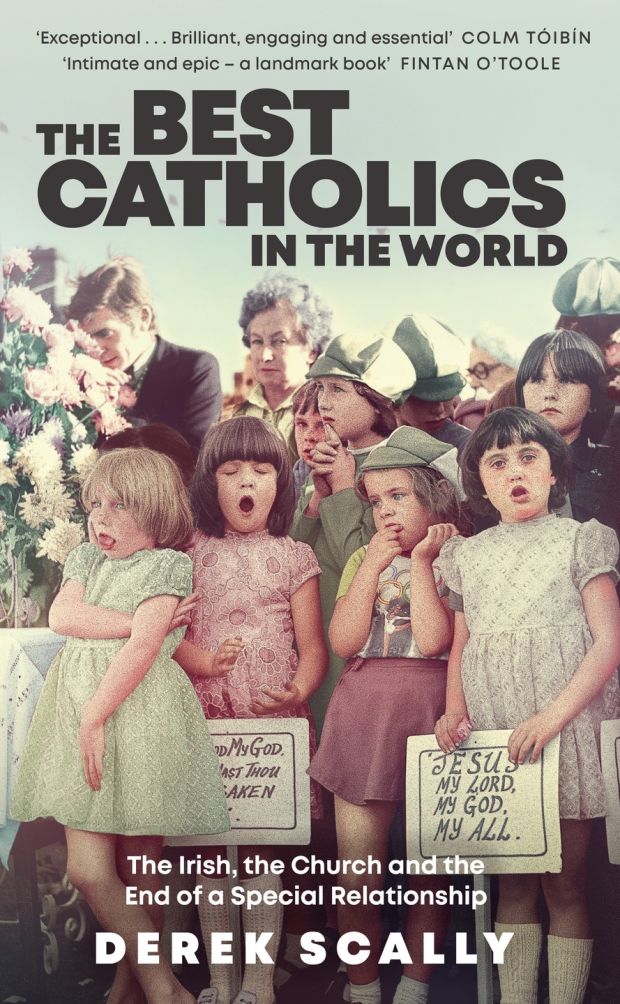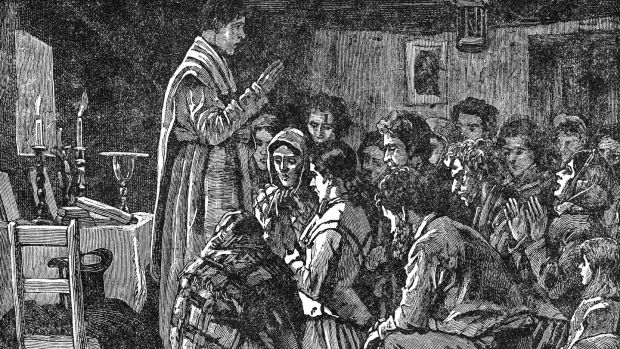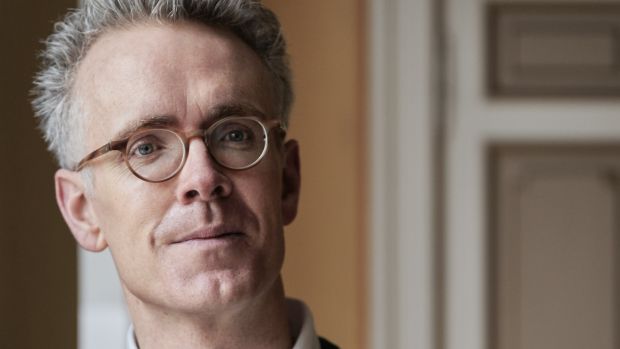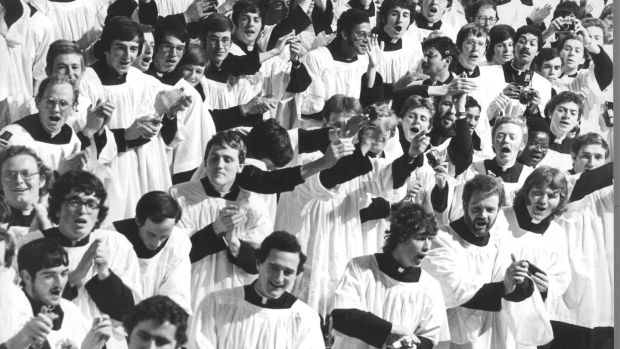DUBLIN (IRELAND)
Irish Times [Dublin, Ireland]
March 20, 2021
By Derek Scally
[Photo above: Priests in Maynooth during the Pope’s visit to Ireland in 1979. Photograph: Eddie Kelly]
An extract from Derek Scally’s new memoir, The Best Catholics in the World, explores Ireland’s self-image of ‘holy victimhood’
On the wall inside the door of my Berlin apartment hangs a bronze penal cross. About 40cm long, it has stubby arms that are distinctive to the crucifixes dating from the era of the Irish Penal Laws, a time when Ireland’s Catholic majority were subjugated by the London-backed Protestant minority.
The cross was created by Imogen Stuart. Throughout her seven-decade career, Stuart has designed penal crosses for churches around the country. She is intrigued by the form and, in time, I have grown to share her fascination, even though I felt awkward accepting the cross as a gift.
Visitors to my apartment eye it warily but, for me, it is as much crossroads as cross: an intersection of my Catholic and Irish identities, which makes for lively inner conflicts. The cross is also a reminder of how Ireland’s penal era lingers in my mind as a vague narrative of brutality towards previous generations who suffered for their Catholic faith. Slipped in alongside this was the religious-nationalist indoctrination: suffering makes you hardier, and holier, than others.
Historian Liam Kennedy suggests such narratives of victimhood and suffering are sometimes empowering, but often sources of dysfunction, “especially when laced with aggressive self-righteousness”.
I feel a flash of self-righteousness when, after a morning of heavy reading about the penal period, I break for lunch with a Danish friend. He lived in Ireland for a time before I was born and I tell him of my research.
“Which penal laws?” he asks. “There were so many.”
In a quiet Greek restaurant in Berlin, far from Ireland, his remark triggers in me an unusual flash of Irish nationalist pique. I sense a brief awakening of a most-oppressed-people-ever sense of victimhood, which I didn’t realise was in me.
As we continue our lunch, my mind is distracted. When we learned about the penal laws in school, I wonder if I was taught to think about the period or to emote? I need to know more, so it’s back to Ireland.

*****
On a sunny Saturday afternoon, a crowd of 60 people are seated in a semicircle of large, oblong rocks dominating a hillside glade. The centre of attention is a large flat rock on higher ground that is serving as an altar.
Behind the softly billowing white cloth that covers the altar is another rock, this one upright and in the shape of an irregular pentagon. Nailed to the stone face is an iron cross.
We’re at a Mass rock in the Hollywood hills, not in California but outside the small Co Wicklow town. All around are the rolling curves of the national park, carved out during the last Ice Age and, in mid-August, a harmonious patchwork of soft green fern and budding purple heather.
It was over these hills and through the Wicklow Gap that St Kevin is said to have wandered to nearby Glendalough, where he set up his monastery and died 1,400 years ago. From the early Irish monasteries, missionaries left these shores around 600 CE to bring Christianity back to Europe. The collapse of the Roman Empire triggered a dark age for European culture until it was lit once more from the pilot light in Ireland. Now, 14 centuries later, the same faith, in a drastic reversal of fortune, faces existential pressures in Ireland.
Today’s crowd has come to pray at this hillside Mass rock, one of dozens of such hidden places dotted around the country. Mostly forgotten places of worship, they came about during an era of colonial cruelty that, in the words of a 19th century writer, saw the country “deeply, horribly saturated in Irish blood”.
Like the landscape around me, the popular memory of penal times is irresistible. Visiting Ireland in 1979 a well-briefed Pope John Paul II recalled the “Mass rocks in the glens and forests by ‘hunted priests’”.
The priests would have slipped through such glens as this past cottages, now ruined, that would have hosted a hundred private so-called station Masses with neighbours and friends.
Today’s crowd reflects Catholic Mass congregations around the country today: senior citizens, some with grandchildren, and just one couple in their forties with their two young children. In his homily, Fr Micheál Comer from Eadestown parish near Naas says many in Ireland have given up on the 2,000-year-old message of Christianity. To those who haven’t, and have just hiked up the hill, his message is encouraging but cautious. “We cannot just do this to feel good about ourselves,” he says, “but to associate with the people who ensured that future generations had the faith – that’s us – and came up here to have Mass in secret.”

*****
As the Mass concludes I wonder what our ancestors would make of the people gathered here for what seems like one of two reasons, sometimes both: spiritual need and silent protest.
One woman in her 60s from nearby Ballymore Eustace is here for the peace, she says: to reflect and to be thankful. Another man, in his early 70s and with agitated eyes, says he is here because he is looking for a respite from modern Ireland.
What, I ask, is modern Ireland for him? A shallow place, he says, where one clergy has replaced another. Unprompted, and without knowing my day job, he denounces the archbishop of modern Ireland: my Irish Times colleague and one of Ireland’s best-known cultural commentators since the 1980s, Fintan O’Toole.
“People will eventually realise he doesn’t actually have anything to offer,” he says. “I’m not sure who put the bishops up on their pedestal, nor how the liberals managed to get up there after.”
He is bewildered at how his one-time Catholic majority has, within the blink of an historical eye, been reduced to a modest, even mocked, minority. Liberals have “fixed” public opinion in Ireland, securing backing for marriage equality and abortion, he says.
Behind the wounded tone it’s clear he preferred the older way, when his group was in the majority. Now things have flipped, and decades of conservative, clerical dominance of Ireland have ended, replaced among some by a new victim mentality.

*****
This mentality – however much it is real and however much imagined – is key to understanding the penal era. Leading historians of the era agree on little else. One, only half-joking, warns me: “This era should come with a health warning.”
What was unique about the penal era in Ireland was that it was a campaign by a Protestant minority against a Catholic majority. Following the Siege of Limerick in 1691, when Jacobite (Catholic) forces were beaten by the opposing Protestant Williamites, a treaty was agreed promising religious freedom for Catholics.
The effect of subsequent new laws was the exact opposite. From then on Catholics were disenfranchised, banned from public office and holding firearms, and punitive laws applied to fundamentals of daily life, from land inheritance to owning a horse.
To “prevent further growth of popery”, laws demanded the registration of priests, allowing one per parish, and banished bishops. With no provision for training new priests in Ireland, some saw a planned extinction of Catholicism.
After 1709, Catholic clergy found themselves trapped between an obligation to register with civil authorities and a papal ban on doing so. In 1714 Bishop Hugh MacMahon of Clogher wrote to the Pope that “priests have celebrated Mass with their faces veiled, lest they should be recognised by those present”.
With a £100 bounty on his head the bishop said he “frequently had to assume a fictitious name and travel in disguise”.
The laws prompted some priests to go underground or flee abroad. Of those who stayed, a number were killed. For example, a Fr Timothy Ryan was arrested and executed in 1726 in Limerick on a charge of marrying a Protestant man and a Catholic wife.
A Fr Nicholas Sheehy, parish priest of Clogheen in Tipperary, was hanged in Clonmel on March 15th, 1766. Four years after his execution, his executioner was himself stoned to death by an angry Catholic mob.
Hearing stories like these reminds me of how the period was presented to me in school: as a plot against the native Irish and their faith, persecuting their priests to be rid of Catholicism in a generation. The suffering was real but somehow its scale seems skewed.
Many historians say the focus of the penal laws lay elsewhere: preserving property and power in Protestant hands. This could, of course, be aided by disenfranchising the native Catholic majority and enticing them, including with force, to convert to Protestantism.
That a mass conversion from Catholicism failed to materialise has been championed by generations of Irish and their leaders as proof of our devotion to the “one true faith”.
But that logic is based on many assumptions, including the assumption that the punitive anti-Catholic laws that existed on paper were implemented in practice, which many historians say was rarely the case. A lot depended on the local Church of Ireland landlord, who rarely had an interest in upsetting his tenants. And many of the laws were kept in terrorem, as a legal threat. “If someone gets too uppity, the law could be dusted off,” says Vincent Morley, a historian specialising in the era.
Just as the implementation of the laws differed widely, so too, it seems, did levels of religious observance. While some Irish Catholics walked miles to get to Mass on Sundays – the people we like to remember – in other regions up to 80 per cent of people stayed away.
Some stayed away for fear of reprisals, but others did not. And many who practised their faith did not creep around the countryside. In Ulster, for instance, plantation policies seized Catholic land and transferred it to the ownership of Protestant settlers.
Though this squeezed the numbers of local Catholics, not even the penal laws brought about the end of public practice. Contemporary records of pilgrimages north to Lough Derg in Co Donegal note how, then as now, “religion is practised freely and openly”.
In 1714 Bishop MacMahon noted pilgrims arriving from all corners of Ireland for the three-month pilgrimage season, with continuous Masses from dawn until midday. “An extraordinary feature of the pilgrimage,” he wrote, “is that none of the Protestants in the locality ever interfere with the pilgrims, although people are forbidden by law of parliament to make it.”
The situation on the ground then appears far more pragmatic than the narrow persecution narrative I remember in school. Even the meaning of the era’s distinctive penal cross design is contested. Generations have learned that its distinctive stubby shape and narrow crossbar made it easier to conceal the cross up a priest’s sleeve.
But it was also a more stable construction that maximised the use of material. In Lough Derg, far from being concealed, such crosses were sold openly to pilgrims.
*****
City-dwelling Irish Catholics seem to have had a better penal era than their country cousins. In 1731, during a search of six religious orders in Dublin, local sheriffs claimed they found no one to arrest; records of the Augustinians and Dominicans from that period record money set aside for “claret to treat the sheriffs in their search”.
In the capital, but also in Cork and Waterford, Catholic bookshops continued to do a brisk trade. It was in this period, historians say, that middle-class Irish Catholics, in their choice of reading material, began absorbing the “anxious severity” of British Catholics.
It’s disconcerting to reconcile the ringing tills of Catholic bookshops in cities with images of furtive, barefoot Mass-goers at a rural Mass rock. Both are part of the narrative: in a dark era for many Catholics in Ireland, others got on with their lives with far less interference.
In total, contemporary reports from around the country in 1731 show a Catholic Church that is bridled, but not decimated: 892 Mass houses; 54 private chapels; 1,445 priests and 549 schools.
The data on priests forced abroad to study for the priesthood tells its own tale. Even as times improved in Ireland, in the second half of the 18th century, half of all ordained Irish priests in continental Europe failed to return home.
The need for priests varied, too: some parts of the country reported such a surplus that in 1742 the Holy See intervened to limit the number of ordinations. Throttling the number of priests from within – reducing the ratio of priests to people and level of pastoral care on offer – was a factor in this period, alongside ordinances from the Crown.
Finally, the narrow Catholic victim narrative overlooks Catholic perpetrators: the massacres and drownings of Protestants at the hands of Catholic mobs; and Irish Catholics who denounced others.
The brother-in-law of Friar James Hegarty betrayed his whereabouts to Crown forces, resulting in the monk’s beheading near Buncrana in 1711. The disgusted neighbours of a clerical bounty hunter in Limerick made sure they had the last word on his gravestone:
Mankind are pleased whene’er a villain dies
Now all are pleased for here Jack Cusack lies
Even some Irish priests embraced opportunities presented by the penal laws. On November 7th, 1714, Bishop Hugh MacMahon wrote from hiding to the Holy See, about how “four magistrates armed with warrants were in search for me, instigated by an unworthy person to whom I had refused a parish”.
A decade later, Bishop Sweetman of Ferns was imprisoned for a time after one of his own priests denounced him to the authorities as enlisting men for a foreign army.
The penal era of the Irish martyr is also the story of the Irish traitor. Like the early Christian era, this period is mythologised as a high point of religious fervour. But maybe it was just the usual group of people any society produced at any time, trying to get by in the circumstances life put their way.
*****
Three centuries on, modern Irish historians say it is important to examine whose agenda is served by accepting without question the penal era as one of “unexampled sufferings” or an “ordeal of persecution unparalleled in the history of mankind”.
Trying to impose subsequently a historical narrative of grace under pressure, they argue, says less about the era in question and more about later generations’ contemporary needs. In the 1850s, for instance, Ireland’s first cardinal, Paul Cullen, with a mix of empathy and fatalistic hyperbole, suggested the “cruel ingenuity” of penal laws was to persecute the religion of the people and see “the Catholic priesthood sent into exile or dragged to the scaffold”.
His concern was not entirely selfless, channelling a popular understanding of the period while burnishing the image of his church as defender and comforter of the oppressed Irish. Along with his reforms of church structure and faith practice, this 19th century framing of the penal era helped his church secure the power it sought – with widespread popular consent.
Today’s historians argue over how conscious or unconscious this push was and whether clerics – themselves Irish – were actively or passively exploiting or channelling emotional resentment for their institution’s ends.
Starting with Maureen Wall’s The Penal Laws in 1961, modern Irish historians have worked to expand the narrative beyond Good Catholics and Evil Protestants. But university lecturers who teach the penal era say they have their work cut out for them, given the firm ideas of each successive year of first-year history students.
Dr Charles Ivan McGrath, associate professor in University College Dublin’s school of history, presents in lectures many facts that contradict the traditional narrative: that many Mass rocks predate the penal period and were the sites of open-air Masses long after chapels and halls were available; or that the penal laws were enacted by parliament in Dublin – not Westminster – by politicians no less Irish than people we are happy to adopt as our own, such as Dean Jonathan Swift and Maria Edgeworth. Not all first years are happy, he says.
“They come in with the victim notion, and I don’t know where to start because this traditional narrative is everywhere,” says Dr McGrath.
In his own work, historian Sean Connolly presents the 18th century penal laws less as an oppressive daily reality and more as window-dressing to appease anti-papal zealots and British politicians looking for a quick populist boost before elections.
“The penal laws did give insignificant local bullies the chance to throw their weight around at the expense of people, but it was not illegal to walk into a church nor was it to go to Mass,” says Prof Connolly, formerly of Queens University Belfast. Even if the laws were designed to ensure Catholicism died out in one generation, Connolly says, it’s “very hard to say how many people really thought that”.
Historian Louis Cullen goes further, suggesting today’s understanding rests on the retrospective narrative created by Cardinal Cullen and a Catholic political-clerical class in the 19th century. To secure and consolidate their grip on power, he argues, they had a “vested interest in exaggerating the magnitude of the Catholic achievement of survival and the background of legal and political discrimination”.
Inevitably, challenging the traditional victimhood narrative has attracted pushback. In 1989 historian Brendan Bradshaw, a Marist priest, took issue with the zeal of modern, revisionist historians to play down the human trauma inherent in the penal era. He argued they embraced a “conception of professionalism which denies the historian access to value-judgments and, therefore, access to the kind of moral and emotional register necessary to respond to human tragedy”.
Bradshaw criticised their reliance on official sources that excised pain from the record, instead of meditating on history, real and remembered. Bradshaw offered instead the idea of the historian as mediator who, besides studying sources, can acknowledge the burden of past tragedy that is “both historically true and humanly responsive”. This approach, “without diminishing the tragedy, pays due regard to the propensity of the historical process for turning the least promising human situations to constructive purpose”.
In a similar fashion historian Vincent Morley takes issue with those who frame the Penal era as more inconvenience than oppression. Casting the net wider to take in popular writing and literature, he says, reveals how Irish Catholics perceived themselves, and thus felt, at the time: resentful at, in their eyes, hordes of heretics oppressing them for their loyalty to the one true faith; furious at being tenants in their own country; unfailingly loyal to the deposed Jacobite house of Stuart against the Dutch interloper, the forces of the Protestant House of Orange.
The penal laws wounded the Irish deeply, he suggests, but he steers away from the term victimhood.
“That has pejorative connotations, a sense of helplessness: ‘We cannot do anything for ourselves, we are always going to be at the bottom of the heap,’” he says. “I don’t get that sense at all from reading literature of the period, instead I see a resolve that things will get better.”
As an example of the wounding, he cites a verse attributed by some to Eoghan Rua Ó Súillebháin which, in English, reads:
‘Tis not the poverty I most detest, Nor being down for ever,
But the insult that follows it, Which no leeches can cure.
Popular memory in the present has contributed considerably to the most-oppressed-people-ever label we sometimes use for ourselves, variously in jest, self-mockery and self-loathing. But historian Oliver Raftery, a Jesuit priest, says this is for many Irish the “touchstone of how Catholics have often read their past and interpreted their historical experience”.
The Cromwellian violence against the Catholic Irish in the late 17th century for supporting Charles I – and the violent retaliation by the Irish against the Protestants on their island – yielded to the legalised discrimination of the 18th, which in turn transitioned into the 19th-century horrors of hunger and emigration. Simply too much for anyone to bear, it is no surprise that Catholic clerics would fashion a coherent narrative of Christian suffering in this life that would be followed by eternal reward in the next.
Even Morley, who is more sympathetic to the penal era suffering narrative, admits: “It would be remarkable if the Church decided to leave such an important asset unused.”
Regardless of the motivations at the time, regardless of their severity, Prof Oliver Raftery suggests the penal laws left a community of people with a “lingering sense of displacement . . . from its own place, its own land, its own environment”.
Persecution, displacement and bloodshed – in memory as much as reality – lent the penal era Catholic Church an authentic legacy of suffering that opened Irish experience to a long tradition of Christian martyrdom and, argues Prof Raftery, gave rise to a narrative of victimhood.
The result: a new “Faith of our Fathers” Catholicism, teaching the 19th century Irish about previous generations, “chained in prisons dark . . . still in heart and conscience free”. (Ironically, the “fathers” of the title are English; it’s a Reformation era hymn about English Catholic martyrs.)
*****
It’s testament to the lingering historical trauma, and how it welded suffering to Irish Catholic identity, that this union has outlived clerical influence over our country. Until the recent decades of scandal, embracing the Irish Catholic framing of our history as a narrative of unquestioned, undifferentiated cleric-led victimhood helped provide cover for abusing clerics. They were men of God who had suffered with us as victims so, for many, simply could not be perpetrators. That category did not compute.
Contemporary Irish historian Charles Ivan McGrath, associate professor of history at University College Dublin, sees an “Irish gene” at work, stubbornly resistant to any historical narrative that questions an exclusive victim role. This defensiveness towards looking in a differentiated way at the past makes for strange alliances in Ireland today, he says, even among his first-year students at UCD. They may have little connection to the Catholic Church yet rush to defend its framing of Irish history.
“People might be horrified by church teaching on homosexuality, for instance,” says Prof McGrath, “but by clinging to the historical crutches of the penal laws people are, perhaps unknowingly, clinging to the church narrative [of our past].”
His concerns were echoed a century ago by Fr William Burke, a historian, who argued in 1914 that Ireland’s penal and Famine tragedies did not result in mass conversions to Protestantism, but pauperised and degraded the people. Unsurprisingly, people clung to these disastrous experiences of the past and, by doing so, altered the Irish personality in the present.
The habits of slavery induced by the penal code have deprived us as a people of that sturdy individualism which respects oneself and respects others, and which is as widely removed from insolence as it is from servility.
In the heather of the Hollywood hills, no one is thinking too deeply about the legacy of the penal laws – even as they act on it. The original worshippers here felt oppressed by the ruling class of their country and their descendants here feel the same sense of exclusion in a secular society. The penal laws are gone, but how we remember that period, and its after-effects, continues to inform – and limit – how we look at our present.
Back in Berlin I look anew at the bronze Penal cross. Its burnished brass is a contested object of Irish faith and memory, a reminder of how the latter became subservient to the former.
The Best Catholics in the World by Derek Scally is published by Sandycove and is available from booksellers online

